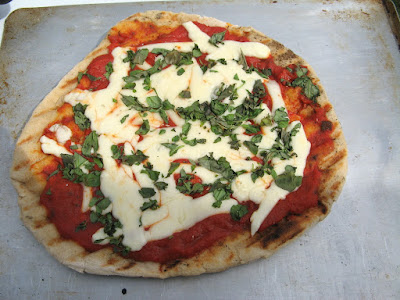Lately, seems like nearly every other with it food blog does grilled pizza.
It's been covered thoroughly on cooking sites as well as blogs.
I'd been tempted to do this, but it seemed daunting. So many things could go wrong. My confidence was shaky.
Fortunately, my blogging buddy, Constantino, has had experience with this technique, and was present to help and give good tips. Most of all, he gave me confidence to proceed. (And two good bottles of wine to go with our lunch.)
(By the way, Constantino doesn't look a bit like the old guy represented in his avatar.)
The problem with baking pizza in our Mexican GE gas oven is that it just doesn't get hot enough to consistently brown the bottom of the crust and quickly cook the toppings. I do use 16 inch, dark colored perforated pizza pans and occasionally get a decent crust bottom, but it's unreliable.
What I'd read about grilled pizza was that you are almost guaranteed a crisped, brown bottom crust. There are, however great differences in the technique from that of oven pizza.
•Basically, the grilled pizza crust is parcooked on one side, turned, toppings added to the cooked side, then finished at somewhat lower heat to amalgamate.
•Different heat zones are required for optimum results.
•Because the pizza is not assembled all at once, but in stages, it's inportant to have all ingredients ready and close by.
•A major doubt in my mind was how to keep the raw dough from sticking to the searingly hot grill bars. Some videos on the Web advise stretching out the dough round on a heavily oiled baking sheet. This turned out to be unnecessary for us. A light brushing of olive oil was all that was needed.
•Constantino gave good advice when he said to slide the half cooked pizza bottom off the heat in order to assemble the toppings. As we lack a proper pizza peel, I used a rimless cookie sheet. That worked quite well for transfers. This halts the cooking of the underside and gives you breathing space in which to assemble.
•Details are important. I'd sliced the cheese into thin strips, but it melted slowly. If I'd shredded it, it would have worked better.
•It's best to use few topping ingredients, and they must all be precooked (except for the cheese) because of the short baking/grilling time.
(One website used simmering, cooked pizza sauce, but that was unacceptable to me. Pizza sauce, IMO, should be uncooked. Mine was a simplified version of my standard, and at ambient temperature.)
In the end, the two pizzas we made were somewhat irregular in shape. One had a scorched bottom, but still tasty. Both were very good eating. Now, with restored confidence, I'd do it again some time.
With great restraint, I'd confined my creative urges to making two kinds of pizza; a Margherita; tomato sauce, cheese and lots of fresh basil.
The other was Bacon and Caramelized Onion, sauce and cheese.
They both were very tasty, had characterful, crisp yet chewy crusts, infused with a little smoke, plus savory toppings. What more could you ask for?
Recipes? I like the pizza dough recipe in The Vegetarian Epicure, Book Two, by Anna Thomas. I reduced the yeast to 1 tsp, and let the dough rise slowly for three and a half hours, in our cool kitchen. I also used three tablespons of rye flour, which adds considerable flavor.
The pizza sauce recipe in the same book is also very good, but you may want to cut back or eliminate some of the many herbal seasonings. I used salt, freshly ground pepper, oregano and garlic, and less than 2 tsps balsamic vinegar. I did not use sugar. I spiked it with some red pepper flakes; just enough to perk up the flavor without causing mouth burn.
The pizza sauce recipe in the same book is also very good, but you may want to cut back or eliminate some of the many herbal seasonings. I used salt, freshly ground pepper, oregano and garlic, and less than 2 tsps balsamic vinegar. I did not use sugar. I spiked it with some red pepper flakes; just enough to perk up the flavor without causing mouth burn.


